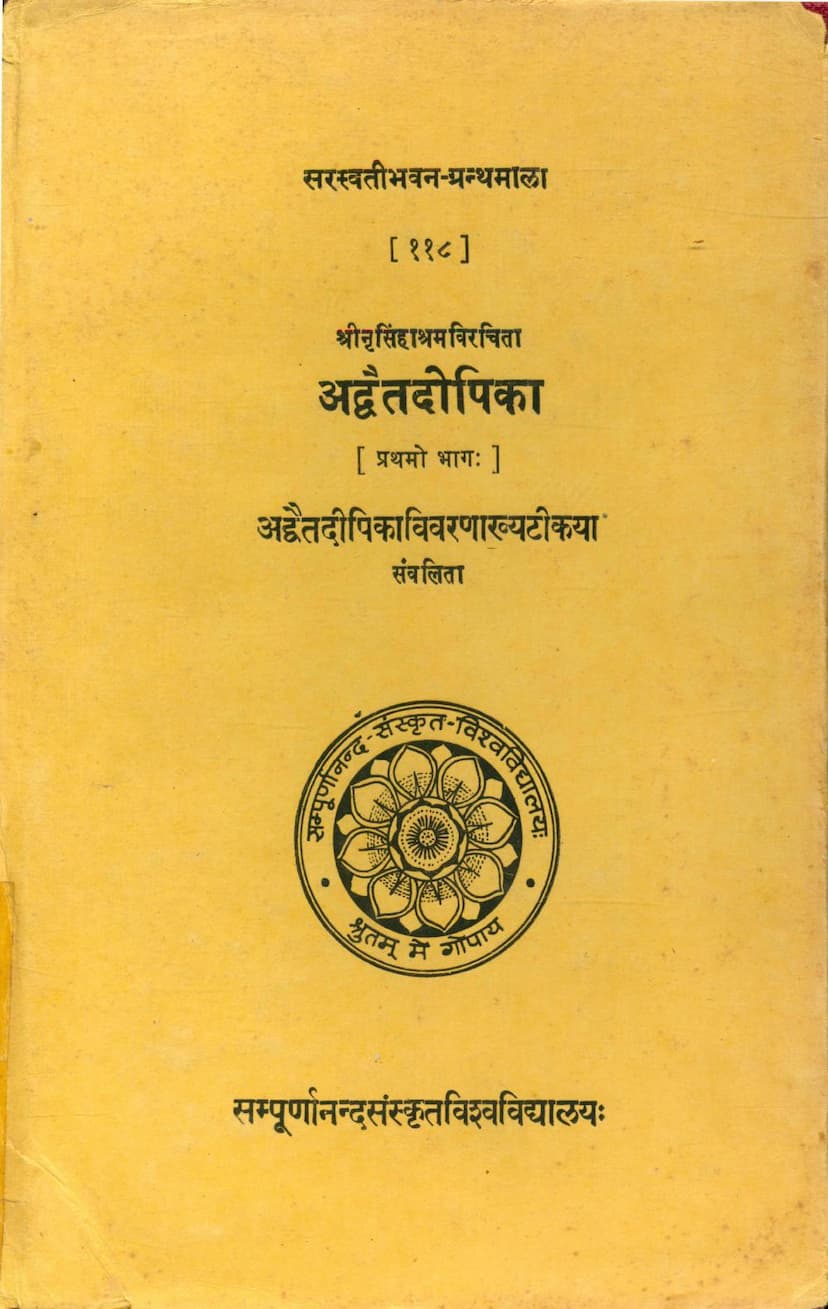Adwait Dipika Part 01
Added to library: September 1, 2025

Summary
Here is a comprehensive summary of "Adwait Dipika Part 01" by Nrisimhasrama, with commentary by Narayanasrama, edited by S. Subrahmanya Sastri:
Overview and Context:
- Title: Advaita Dipika (Torch of Non-dualism) Part 01.
- Author: Svamin Nrisimhasrama (16th century).
- Commentary: Advaita Dipika Vivaranam by Narayanasrama.
- Publisher: Sampurnanand Sanskrit Vishvavidyalaya, Varanasi.
- Foreword: Dr. Gaurinath Sastri (Vice-Chancellor of Sampurnanand Sanskrit University).
- Publication Year: 1982.
- Purpose: To explain the Advaitin (Monistic Vedanta) position on Brahman, the non-dual reality, and the Jiva (individual soul) and universe. It also aims to refute criticisms of Advaita, particularly those found in Jayatirtha's "Nyayasudha," which was written to assail Monistic Vedanta.
Key Themes and Arguments:
The book, as explained in the foreword and table of contents, delves into core Advaita Vedanta concepts, primarily focusing on refuting opposing viewpoints and establishing the non-dual nature of reality. The author Nrisimhasrama, known for his scholarship in Nyaya and Vedanta, uses logical reasoning and scriptural authority to present his arguments.
Central Discussions and Topics Covered:
-
The True Nature of the Jiva (Individual Soul):
- The text begins by examining the identity between "Tat" (Brahman) and "Tvam" (Jiva) as stated in the Upanishadic mantra "Tat Tvam Asi" (That Thou Art).
- It systematically eliminates misconceptions about the Jiva, clarifying that the individual self is not the physical body, senses, vital breath, or mind.
- Through the Chandogya Upanishad, the author distinguishes the Atman from the ego (Ahankara) and emphasizes the Atman's transcendence of all sheaths or coverings.
- The text addresses criticisms, such as Jayatirtha's contention that "aham" in the Pancaratra Agama refers to Aniruddha, not Ahankara, refuting it based on the principle of six criteria for interpreting scriptural passages.
-
The Nature of Anandamaya:
- Nrisimhasrama discusses the Anandamaya (bliss-sheath) mentioned in the Taittiriya Upanishad.
- He disagrees with some interpretations that "abhyasa" (repetition) refers to Anandamaya itself, arguing it pertains to Ananda (bliss). The suffix "maya" indicates transformation or change, similar to "annamaya" (food-sheath).
- Ananda is identified with Brahman.
-
Rejection of Anuvyavasaya and Positing of Saksin:
- The Advaitin view rejects the Naiyayika concept of "Anuvyavasaya" (secondary cognition, e.g., "I know this pot").
- Instead, the Advaitins posit the "Saksin" (witness) or Atman, who cognizes the primary cognition and all mental activities. The Saksin is the ultimate illuminator.
-
The Role of Vrtti (Mental Modification) and Vrttijñana (Knowledge through Vrtti):
- The Advaitins acknowledge the utility of "Vrttijñana" (knowledge arising from sense-object contact) for removing "Ajñana" (ignorance) about a particular object.
- Atman, being pure consciousness, cannot repel Avidya. Only Vrttijñana can dispel ignorance.
- The process involves the mind's "Vrtti" flowing through the senses, pervading the object, and removing the ignorance veiling the object-conditioned consciousness. This then reveals the object.
- This process applies to perception of external objects and is also extended to inferential knowledge (anumana), scriptural testimony (shabda), etc., where Vrtti arises within the mind.
-
The Nature of Jnana (Knowledge):
- The text questions whether Jnana is the modification of the mind (Vrtti) or Brahman itself.
- It argues that Vrtti is not Jnana because it is not self-luminous. Brahman alone is self-luminous.
- Vrtti is also not Brahman, as the experiences of "knowledge is born" or "knowledge perishes" would be inexplicable if Vrtti were Brahman.
- The resolution is that Jnana is Brahman consciousness conditioned by Vrtti. It is neither pure Brahman nor pure Vrtti.
-
Other Key Topics Discussed:
- Bliss: Bliss is not an attribute of Brahman but its very essence. Pain is a quality of the mind, overcome upon realizing Brahman.
- Size of Atman: Atman is ubiquitous and explained through various Brahma Sutras.
- Agency (Kartetva): Agency is not an attribute of Atman, indicated by scriptural texts using "iva" (as if) to show it's an apparent action due to Adhyasa (superimposition).
- Falsity of Duality: Supported by Upanishadic texts like "Yatra hi dvaitam iva pasyati" (Where one sees duality, as it were).
- Avidya Nivritti (Cessation of Ignorance): It is not destruction but cessation of existence. With Brahman-knowledge, Ajñana ceases to exist.
Editorial and Scholarly Merit:
- Dr. Gaurinath Sastri highlights the importance of Nrisimhasrama's work in explaining the monistic viewpoint and refuting criticisms.
- The editor, S. Subrahmanya Sastri, is praised for his profound scholarship in Nyaya, Mimamsa, and Advaita Vedanta, making him a "Sarva-tantra-svatantra" (master of all disciplines).
- The work is presented as a valuable resource for understanding Advaita Vedanta in its pure form, particularly its refutation of dualistic criticisms.
In essence, "Adwait Dipika Part 01" is a rigorous philosophical treatise that systematically dissects and defends the Advaita Vedanta doctrine of non-duality, using sophisticated reasoning and scriptural analysis to establish the supremacy of the singular, unconditioned Brahman as the ultimate reality, with the individual soul being identical to it.